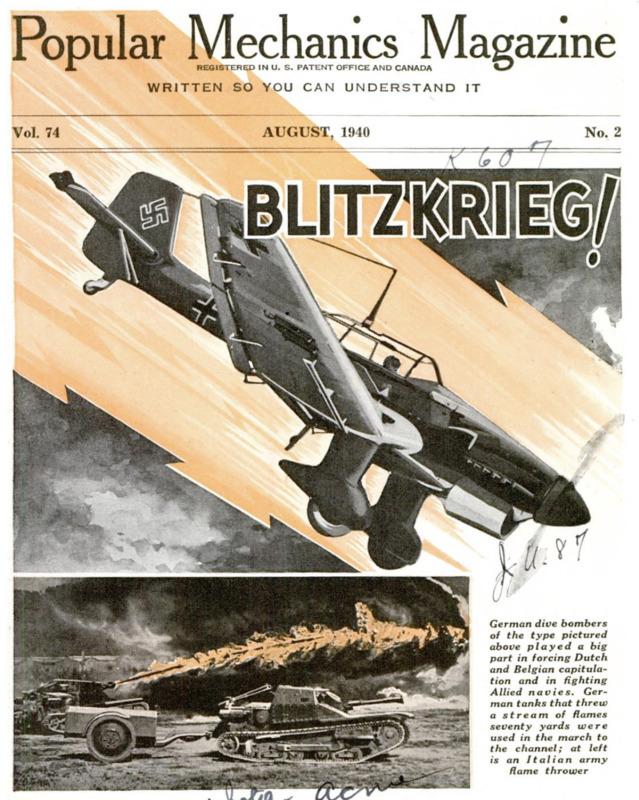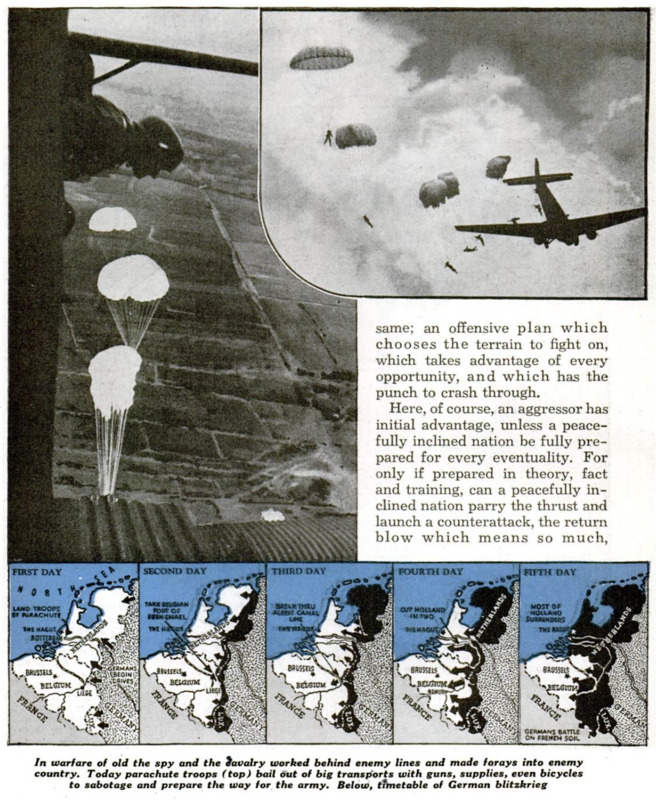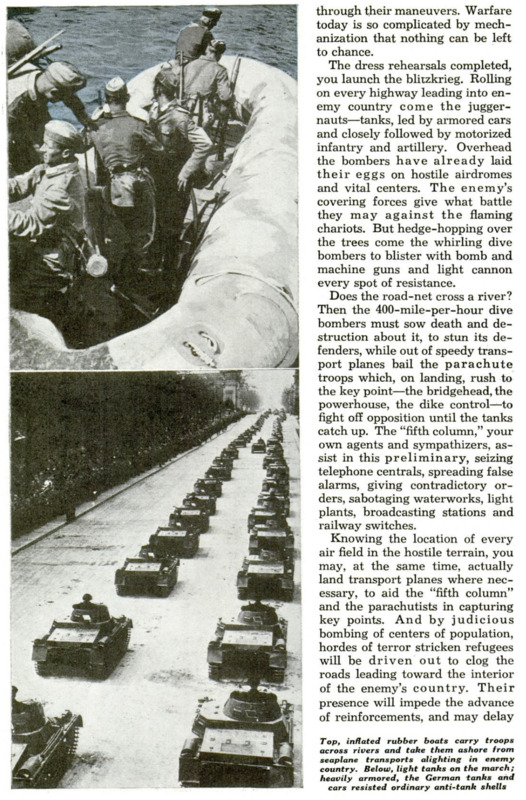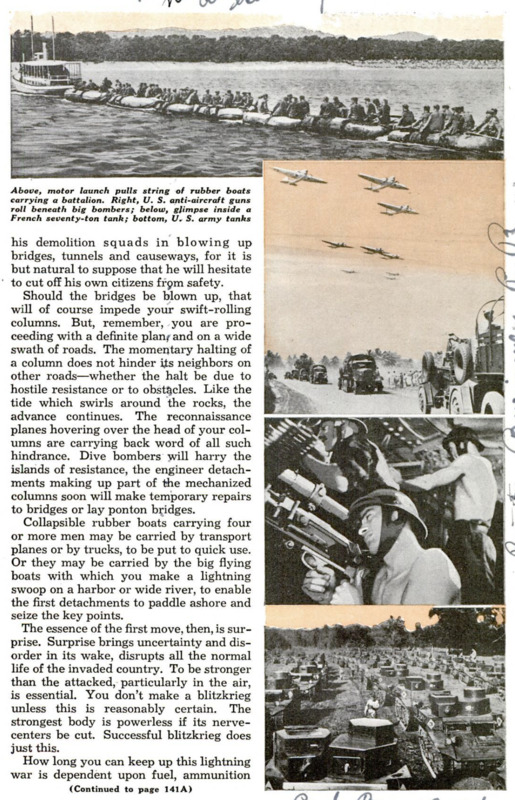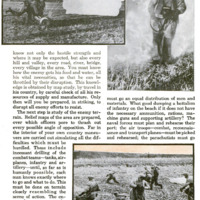LESS than a year ago a siren voice was heard: “Stay on the defensive - modern weapons are so murderous that whoever takes the offensive is doomed.” A part of the world believed; another part - professional soldiers these - disbelieving, found themselves without an audience. Distrust history, sang the siren. Forget Genghis Khan, Frederick the Great, Washington’s sweep to Yorktown, Napoleon's 1805 campaign to Austerlitz, Robert E. Lee in the Shenandoah Valley, Grant before Vicksburg and again at Appomattox, Allenby in Palestine. Forget that surprise, speed and striking power offensively used have won every previous campaign. Today that siren is silent, An amazed world prates of blitzkrieg, the lightning war, as something new under the sun. This is an error. What is new is the technique, the utilization of scientific advances - mainly the internal-combustion engine and everything it made possible - which has geared warfare to a heretofore un- thinkable rapidity of movement. The basic elements of success in war remain the same; an offensive plan which chooses the terrain to fight on, which takes advantage of every opportunity, and which has the punch to crash through. Here, of course, an aggressor has initial advantage, unless a peacefully inclined nation be fully prepared for every eventuality. For only if prepared in theory, fact and training, can a peacefully inclined nation parry the thrust and launch a counterattack, the return blow which means so much, whether in the boxing arena or in war. To realize this, one must see just what this blitzkrieg amounts to, and what are the parries by which the attacked can check the blow, in order to strike back. There are several essential ingredients to the successful blitzkrieg. First, you must be prepared. Second, you must know where you want to go. Then you must know not only the hostile strength and where it may be expected, but also every hill and valley, every road, river, bridge, every village in the area. You must know how the enemy gets his food and water, all his vital necessities, so that he can be throttled by their disruption. This knowledge is obtained by map study, by travel in his country, by careful check of all his resources of supply and manufacture. Only then will you be prepared, in striking, to disrupt all enemy efforts to resist. I The next step is study of the enemy terrain. Relief maps of the area are prepared, over which officers pore to thrash out every possible angle of opposition. Far in the interior of your own country maneuvers are carried out simulating all the difficulties which must be hurdled. These include incessant drilling of the combat teams - tanks, airplanes, infantry and artillery - until, so far as is humanly possible, each man knows exactly where to go and what to do. This must be done on terrain closely resembling the scene of action. The enemy language must be studied, in elementary form at least. If an overseas expedition is planned, the avance ground elements must be drilled in loading and unloading the transports. Into each vessel must go an equal distribution of men and materials. What good dumping a battalion of infantry on the beach if it does not have the necessary ammunition, rations, machine guns and supporting artillery? The naval forces must plan and rehearse their part; the air troops - combat, reconnaissance and transport planes - must be picked and rehearsed; the parachutists must go through their maneuvers. Warfare today is so complicated by mechanization that nothing can be left to chance.The dress rehearsals completed, you launch the bliizkrieg. Rolling on every highway leading into enemy country come the juggernauts - tanks, led by armored cars and closely followed by motorized infantry and artillery. Overhead the bombers have already laidtheir eggs on hostile airdromes |and vital centers. The enemy’s covering forces give what battle they may against the flaming chariots. But hedge-hopping over the trees come the whirling dive bombers to blister with bomb andmachine guns and light cannon every spot of resistance. Does the road-net cross a river? Then the 400-mile-per-hour dive bombers must sow death and destruction about it, to stun its defenders, while out of speedy transport planes bail the parachute troops which, on landing, rush tothe key point - the bridgehead, the powerhouse, the dike control – to fight off opposition until the tanks catch up. The “fifth column,” your own agents and sympathizers, assist in this preliminary, seizing telephone centrals, spreading false alarms, giving contradictory orders, sabotaging waterworks, light plants, broadcasting stations and railway switches. Knowing the location of every air field in the hostile terrain, you may, at the same time, actually land transport planes where necessary, to aid the “fifth column” and the parachutists in capturing key points. And by judicious bombing of centers of population, hordes of terror stricken refugees will be driven out to clog the roads leading toward the interior of the enemy’s country. Their presence will impede the advance of reinforcements, and may delay his demolition squads in blowing up bridges, tunnels and causeways, for it is but natural to suppose that he will hesitate to cut off his own citizens frgm safety. Should the bridges be blown up, that will of course impede your swift-rolling columns. But, remember, you are proceeding with a definite plansand on a wide swath of roads. The momentary halting of a column does not hinder its neighbors on other roads - whether the halt be due to hostile resistance or to obstgcles. Like the tide which swirls around the rocks, the advance continues. The reconnaissance planes hovering over the head of your columns are carrying back word of all such hindrance. Dive bombers will harry the islands of resistance, the engineer detachments making up part of the mechanized columns soon will make temporary repairs to bridges or lay ponton bridges. Collapsible rubber boats carrying four or more men may be carried by transport planes or by trucks, to be put to quick use. Or they may be carried by the big flying boats with which you make a lightning swoop on a harbor or wide river, to enable the first detachments to paddle ashore and seize the key points. The essence of the first move, then, is surprise. Surprise brings uncertainty and disorder in its wake, disrupts all the normal life of the invaded country. To be stronger than the attacked, particularly in the air, is essential. You don’t make a blitzkrieg unless this is reasonably certain. The strongest body is powerless if its nerve centers be cut. Successful blitzkrieg does just this. How long you can keep up this lightning war is dependent upon fuel, ammunition and food. The mechanized units, which can go 200 miles or more a day when unimpeded, carry two days’ rations for man and motor. If the first bound carries you through the covering forces and fortifications, the further you go and the faster you move, the easier the going is along that particular line. It is quite possible that, since the roads and resources along those roads are known, fuel and food may be seized. If that be impossible, you must arrange for fast-shuttling motor supply convoys to bring up fuel, ammunition and food daily, while the spearheads of the advance may also be replaced by fresh reinforcing tanks and combat cars which will leapfrog tomorrow the squadrons which started the drive today. Lest hostile planes take the air from dromes you have not found and bombed, squadrons of pursuit planes cover the advance, to protect both the mechanized units and their following motorized infantry, and also your own attack aviation; that is your antiaircraft artillery, motorized of course, is rolling with your own columns to furnish additional protection to them and to the bridges and tunnels you have seized. It all sounds diabolical, fantastic and terrifying. It is. But never has man developed any weapon or technique for harassing his fellowman that antidotes have not been found. The backbone of defense is discipline: training that holds men together in stress, together with a planned organization. Airdrome runways sown with concrete blocks prevent hostile landings. These blocks must be movable, else wehinder our own air power from action, and ground crews must be trained to scatter them and replace them. Runways may be split by traps - counterparts of the drawbridges of old - to be tripped or replaced at a signal. Highways, too, may be so safeguarded. Bridges must be mined, under the control of men who will, without hesitation, blow them up, when necessary. Waterworks, power plants, telephone and telegraph centrals, radio stations, supply dumps and factories, must be guarded from the “fifth column.” The covering forces - outpost troops - must be trained soldiers. They must be equipped with antiaircraft and antitank guns to cripple and slow down the first rush, Behind them garrisoned where they can be rushed to the place we decide to launch our counterattack, must be the mobile main body, also trained troops. They must be protected by antiaircraft and antitank artillery. Their own spearheads must be mechanized, that they may shoot into the area into which the enemy has swept and in turn disrupt his communications. Stone-wall defense is impossible, since we cannot be strong in all places at the same time. Once a stone wall is pierced, the path is free for the invader. But our own fortifications must be so arranged that we may use them to protect a flank of the counterattack. Modern war differs from the past only in that we must think in terms of hundred-mile bounds instead of miles, of minutes instead of days. The world has done this in its peacetime traffic systems. It must do it in war. Our air force must be prepared to leap into action - to harass, to strafe, to get in formation. This it must do in close coordination with the ground troops and the navy. Alone, the air force is as useless as a battery of artillery without support. Combined with the other members of the combat team, it becomes a vital force. Antiaircraft warning systems, by which all the communications resources of the nation will be linked to spread the alarm of approaching aircraft, are essential. Part of this defense net must consist of locally organized bodies of home-defense forces prepared to shoot down the parachutists. The parachute technique is to drop armed men. These reach the ground scattered over comparatively wide space. They must rally into fighting units, must retrieve the machine guns and extra ammunition dropped at the same time. It is not as individuals but as groups that they are dangerous. On the highways, road-building equipment in the hands of trained men may be transformed into road-breaking equipment. Any and every means which will slow down the mechanized forces puts the brakes on blitzkrieg, paves the way for the decisive counterblow. But it cannot be done by theory alone, it cannot be left to untrained individual initiative. It must be planned, it must be organized. The success of a blitzkrieg is definitely dependent upon ability to follow up the mechanized spearheads with the main body of troops which will organize the ground swept over in the first rush, open the way for unimpeded supply and reinforcement, and mop up the remaining enemy troops. Once the other fellow has time to draw breath, the initiative has been yielded by the attacker. And the essence of it all is time. A counterattack cannot be launched until the direction and extent of the blow be definitely known. One must first parry, get set, then return the blow. Better still, and certainly less nerve racking, is not only to match the other fellow ship for ship, gun for gun, trained man for trained man, in the air, on the land and on the sea, but also to raise the ante. The pleasant thing about that is that then there probably won't be any blitzkrieg. Or at least the “blitz” won't be on our home folks.
